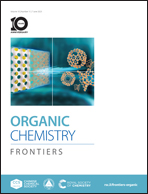Exploring a general mechanistic map on NHC-catalyzed activation/transformation reactions of saturated carboxylic anhydrides†
Abstract
A general mechanistic map involving multiple intermediates and pathways has been proposed and systematically studied for NHC-catalyzed transformation reactions of saturated carboxylic anhydrides. Based on the map, the origin of chemo- and stereo-selectivities has been predicted in a case study of the NHC-catalyzed reaction of saturated carboxylic anhydride with benzylidene diketone. Computational results show that the fundamental pathway of this kind of reaction mainly includes the following processes: the C–O bond cleavage for the formation of acyl azolium, α-H elimination for the formation of enolate, β-H elimination for the formation of a Breslow intermediate, β-C functionalization with benzylidene diketone, acyl migration, aldol addition, dissociation of catalyst, and decarboxylation. The Michael-type addition process is identified to be the stereoselectivity-determining step, with an SR-configured product being generated preferentially. In addition, the other two chemoselective pathways, including the hetero-Diels–Alder and Stetter pathways, are also considered. The chemoselectivity is successfully predicted by comparing the energy gap of FMO between the two interactive partners, which could provide a general guideline in that FMO analysis can be used for predicting the potential chemoselectivities of organocatalytic reactions.



 Please wait while we load your content...
Please wait while we load your content...